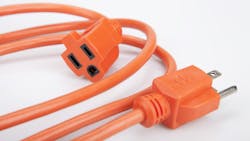Portable cords aren’t going away anytime soon. They have long been a critical part of maintenance and construction work, and when treated properly, they are reliably safe. So how should you treat them? Here are some tips.
- If you’re working around oil or water, use a cord that’s rated for such an environment. Oil itself can degrade the insulation, causing damage you might not see. Cords labeled for wet usage are tested for that environment, and they give you the desired protection because they are designed to pass the test.
- Never walk on it. This breaks down the insulation.
- Never clean it with a petroleum-based solvent or any kind of oil (light or otherwise).
- Where practical, route it away from walkways and lift truck paths. Where not practical, use cord trees to route it over such paths. If you use cord trees, ensure they are tall enough to prevent the cord from contacting pedestrians or vehicles below.
- Run it along the side of steps, rather than across them. Don’t be afraid to use tape to secure it in place. If you must run across a step, push the cord all the way to the back, and secure it with tape.
- Don’t use staples, saddle clamps, or similar (which are meant for permanent use) to secure your portable cord. Secure it to devices designed for portable cord routing, not to the building structure and not to any piping or raceway.
- If you use wire ties to secure portable cord, ensure you don’t bite into — or even compress — the cord jacket. Barely snug them.
- Don’t repair a damaged cord. Yes, you can cut off the damaged part and install a new plug. But don’t attempt to fix a damaged cord jacket with tape or other means. You simply cannot produce a safe cord this way.
- Respect the bend radius. Never wind a cord up tight enough to put even a slight kink in the jacket. And don’t tie it back on itself for storage. One way to store a cord so you don’t damage it is to make nice big loops with it, about the length of your arm. Then twist the resulting collections of loops once across the middle so you have a sort of loose letter eight. You can use a short piece of twine or some tape to hold this shape in place. Or use hook and loop fasteners that are made for cable management. An even simpler method is to just buy a cord spool that’s made for portable cords.
About the Author

Mark Lamendola
Mark is an expert in maintenance management, having racked up an impressive track record during his time working in the field. He also has extensive knowledge of, and practical expertise with, the National Electrical Code (NEC). Through his consulting business, he provides articles and training materials on electrical topics, specializing in making difficult subjects easy to understand and focusing on the practical aspects of electrical work.
Prior to starting his own business, Mark served as the Technical Editor on EC&M for six years, worked three years in nuclear maintenance, six years as a contract project engineer/project manager, three years as a systems engineer, and three years in plant maintenance management.
Mark earned an AAS degree from Rock Valley College, a BSEET from Columbia Pacific University, and an MBA from Lake Erie College. He’s also completed several related certifications over the years and even was formerly licensed as a Master Electrician. He is a Senior Member of the IEEE and past Chairman of the Kansas City Chapters of both the IEEE and the IEEE Computer Society. Mark also served as the program director for, a board member of, and webmaster of, the Midwest Chapter of the 7x24 Exchange. He has also held memberships with the following organizations: NETA, NFPA, International Association of Webmasters, and Institute of Certified Professional Managers.
